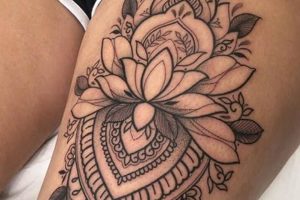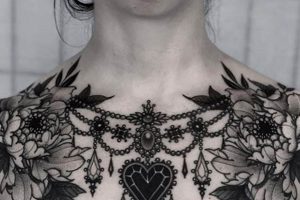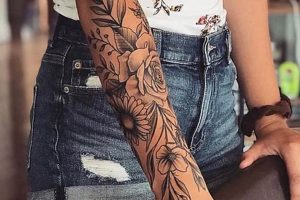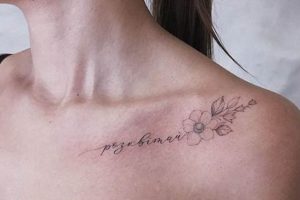Transforming unwanted ink into new expressions of personal style is a growing trend. This involves strategically designing and placing a new tattoo to completely obscure a previous one, whether due to dissatisfaction with the original design, changes in personal taste, or the desire for a fresh start. For example, a faded, amateur tribal tattoo can be reimagined as a vibrant floral piece, or a name of a past relationship can be transformed into an empowering symbolic image.
The process offers individuals the opportunity to reclaim their body art and tell a new story. It can be a powerful way to move forward, leaving behind unwanted memories or associations. Beyond the aesthetic benefits, these transformations can also have a positive psychological impact, boosting confidence and self-esteem. While tattooing has a rich history across cultures, the concept of cover-ups has become increasingly sophisticated with advancements in tattoo artistry and techniques.
Several factors influence the success of this transformative process, including the size, color, and location of the original tattoo, as well as the skill and expertise of the tattoo artist. Understanding the complexities of ink saturation, color theory, and design principles is essential for creating a seamless and aesthetically pleasing result.
Tips for Successful Tattoo Transformations
Careful planning and consideration are crucial for achieving optimal results when concealing previous tattoos. The following tips offer guidance for navigating the process effectively.
Tip 1: Consult with Experienced Artists: Seek out artists specializing in cover-up work. Their expertise in color theory, design principles, and ink saturation is essential for successful transformations.
Tip 2: Assess the Existing Tattoo: Factors like size, color saturation, and location significantly impact cover-up options. Darker, larger tattoos require more intricate and strategic designs.
Tip 3: Embrace Larger Designs: Cover-ups often necessitate larger designs than the original tattoo to effectively conceal the previous artwork. Be prepared to commit to a more substantial piece.
Tip 4: Consider Color Carefully: Darker colors are more effective at covering existing ink. Artists skilled in color theory can strategically use color to create visually appealing and effective cover-ups.
Tip 5: Explore Different Styles: Various styles, such as watercolor, realism, or geometric patterns, can be effectively employed for cover-ups. Discuss options with the artist to determine the most suitable style for individual needs and preferences.
Tip 6: Manage Expectations: Complete concealment may not always be possible. Realistic expectations are crucial for a positive experience. Experienced artists can offer honest assessments and achievable solutions.
Tip 7: Prioritize Aftercare: Proper aftercare is essential for both the new tattoo and the successful concealment of the old. Follow artist instructions diligently to promote healing and optimal ink retention.
By following these guidelines, individuals can maximize the likelihood of achieving a successful and aesthetically pleasing transformation, turning unwanted ink into a source of renewed confidence and self-expression.
Ultimately, successful transformation relies on informed decision-making and collaboration with a skilled artist.
1. Size and Placement
The size and placement of the original tattoo significantly influence cover-up design possibilities. Larger tattoos necessitate more extensive coverage, often requiring larger and more complex designs. Smaller tattoos offer greater flexibility, allowing for a wider range of cover-up options. Placement plays a crucial role; tattoos located on areas with more muscle or fat, such as the thigh or upper arm, provide a more forgiving canvas compared to areas with thinner skin or bone proximity, like the wrist or ankle. A large, darkly saturated piece on the back might require a full-back design incorporating elements like animals, landscapes, or intricate patterns to effectively conceal the previous artwork. Conversely, a small, faded tattoo on the wrist could be covered with a delicate floral design or a symbolic image.
Careful assessment of the original tattoo’s dimensions and location is essential for determining the appropriate scale and complexity of the cover-up. This assessment informs design choices, ensuring the new tattoo adequately conceals the unwanted ink. For example, a name tattooed on the forearm might be effectively covered by a band of flowers, while a portrait on the chest might require a larger, more detailed design to fully obscure the original image. The artist’s skill in utilizing negative space, incorporating existing lines, and strategically placing new elements becomes particularly important when working with challenging placements or larger pre-existing tattoos.
Understanding the interplay between size, placement, and design options is crucial for a successful cover-up. This understanding allows for realistic expectations and informed decision-making during the design process. It also enables clients and artists to collaborate effectively, resulting in a cohesive and aesthetically pleasing outcome that addresses both practical considerations and aesthetic preferences. Ignoring these factors can lead to unsatisfactory results or even unsuccessful cover-ups, highlighting the importance of this initial assessment.
2. Color and Style
Color and style play pivotal roles in successful tattoo cover-ups, particularly for women seeking to transform existing ink into aesthetically pleasing and personally meaningful artwork. Color theory is paramount; darker colors effectively conceal existing ink, while lighter colors require strategic layering and blending. Understanding color saturation, undertones, and the interplay of colors is crucial for achieving desired results. Style selection influences not only the aesthetic outcome but also the cover-up’s effectiveness. Bold styles like traditional, neo-traditional, or realism offer strong coverage due to their solid color packing and defined lines. These styles can effectively mask darker or more intricate previous tattoos. Conversely, lighter, more delicate styles like watercolor or fine line might be less effective for covering dense or dark ink. A watercolor tattoo, while visually appealing, might not fully obscure a pre-existing tribal design due to its translucent nature.
Consider a scenario where a woman wants to cover a dark, tribal armband with a floral design. An experienced artist might choose a bold traditional or neo-traditional style, employing rich, opaque colors to effectively conceal the tribal ink. Deep reds, greens, and blues in the floral design would not only create a visually striking piece but also ensure sufficient coverage of the darker underlying pigment. Alternatively, attempting to cover the same tribal band with a pastel watercolor design would likely result in the original tattoo showing through, compromising the aesthetic integrity of the new artwork. For women seeking to cover names or dates, incorporating the existing ink into a larger, more symbolic design can be an effective strategy. A name might be woven into the stem of a rose, or a date might become part of a geometric pattern, effectively transforming the unwanted ink into a meaningful element within the new artwork.
Effective cover-up design requires careful consideration of color and style. These elements work in concert to achieve both aesthetic appeal and effective concealment. Ignoring the interplay of color and style can lead to suboptimal results, emphasizing the importance of consulting with skilled artists experienced in cover-up techniques. Artists can guide color selection, suggest appropriate styles, and develop designs that address individual needs and aesthetic preferences, ensuring a successful and satisfying transformation. The integration of color theory and stylistic choices provides a pathway for women to reclaim their body art and express themselves through visually compelling and personally meaningful designs.
3. Artist Selection
Selecting a qualified artist is paramount for successful tattoo cover-ups, especially for women seeking to transform existing ink into aesthetically pleasing and personally meaningful artwork. A skilled artist possesses a deep understanding of color theory, design principles, and skin anatomy. This expertise is crucial for effectively concealing unwanted tattoos while creating visually appealing new designs. Experience in cover-up techniques equips artists to assess the complexities of existing ink, including color saturation, depth, and scarring. This assessment informs design choices, ensuring the new tattoo adequately addresses these challenges. A portfolio showcasing successful cover-ups demonstrates an artist’s proficiency in this specialized area. For example, an artist skilled in realism can create hyperrealistic designs that seamlessly integrate with existing skin tones and textures, effectively concealing unwanted ink beneath a visually captivating image. Similarly, an artist specializing in blackwork can use bold lines and intricate patterns to create visually striking cover-ups that completely obscure previous tattoos.
Choosing an artist solely based on price or proximity can lead to unsatisfactory results. An inexperienced artist may lack the technical skills and artistic vision to effectively address the complexities of cover-ups. This can result in the original tattoo showing through, uneven ink saturation, or a design that fails to meet expectations. Conversely, investing time in researching and selecting a qualified artist specializing in cover-ups significantly increases the likelihood of a successful and satisfying outcome. Consulting with multiple artists, reviewing their portfolios, and discussing design ideas allows individuals to make informed decisions based on skill level, artistic style, and experience. For instance, a woman seeking to cover a name on her wrist might consult with an artist known for delicate floral designs. The artist’s portfolio might showcase examples of similar cover-ups, demonstrating their ability to seamlessly integrate the existing ink into a beautiful and meaningful new piece.
Artist selection is a critical factor in the success of tattoo cover-ups. Prioritizing experience, skill, and artistic vision ensures a transformative process that results in aesthetically pleasing and personally meaningful body art. Thorough research and consultation empower individuals to make informed decisions, maximizing the potential for a positive and fulfilling experience. Ultimately, selecting a qualified artist represents an investment in a successful and lasting transformation, enabling women to reclaim their body art and express themselves with confidence and creativity. This careful selection process contributes significantly to the overall satisfaction and positive impact of the transformative journey.
4. Meaningful Imagery
Meaningful imagery forms a cornerstone of successful cover-up tattoos, particularly for women seeking to transform existing ink into powerful symbols of personal growth and renewal. Cover-ups often represent a turning point, a desire to move beyond past experiences or shed unwanted reminders. Incorporating imagery that resonates deeply with personal narratives allows the new tattoo to become a source of empowerment and healing. This connection between imagery and personal meaning elevates the cover-up beyond a purely aesthetic procedure, transforming it into a ritual of reclaiming one’s body and narrative. Choosing images that symbolize strength, resilience, or new beginnings can imbue the cover-up with a sense of purpose and positive transformation. For example, a phoenix rising from ashes can represent overcoming adversity, while a lotus flower symbolizes purity and rebirth. These symbolic images not only conceal unwanted ink but also serve as visual affirmations of personal growth and resilience. Geometric patterns, mandalas, or spiritual symbols can also hold deep personal significance, offering a pathway to connect with inner strength and express individuality.
The selection of meaningful imagery requires introspection and careful consideration. Factors such as cultural background, personal beliefs, and life experiences influence image selection. Consulting with skilled artists facilitates this process, allowing for collaborative exploration of symbolic representation and artistic expression. Artists can offer guidance on incorporating personal narratives into visually compelling designs, ensuring the cover-up resonates authentically with individual experiences. For example, a woman seeking to cover a tattoo associated with a past relationship might choose a butterfly, symbolizing transformation and new beginnings. The artist could then incorporate elements representing personal growth or hobbies into the butterfly’s wings, creating a unique and deeply personal piece of art. Similarly, a woman covering a scar might choose a design that incorporates elements of nature, representing healing and the interconnectedness of life.
The integration of meaningful imagery transforms the cover-up experience into a powerful act of self-expression and reclamation. This approach moves beyond simply concealing unwanted ink, offering a pathway to healing, growth, and renewed self-confidence. The careful selection of symbolic imagery imbues the new tattoo with profound personal significance, allowing it to become a source of strength and a visual representation of personal transformation. Addressing the emotional and psychological aspects of cover-ups, alongside the technical and aesthetic considerations, contributes to a more holistic and fulfilling experience. This emphasis on meaningful imagery fosters a deeper connection between the individual and their body art, empowering them to tell their stories with authenticity and resilience.
5. Budget and Timeframe
Budget and timeframe are integral components when considering cover-up tattoos. Cover-up procedures often involve multiple sessions, particularly when addressing larger or more complex existing tattoos. The size, color density, and location of the original tattoo directly influence the time required for complete coverage. Intricate designs, extensive color blending, or the need for multiple layers of ink contribute to increased artist labor and longer sessions. These factors consequently impact overall cost. A larger cover-up requiring multiple sessions naturally incurs a higher cost than a smaller, less complex design completed in a single session. For example, covering a full sleeve tattoo with a new, intricate design might require multiple four to six-hour sessions over several months, representing a substantial financial investment. Conversely, covering a small, faded tattoo on the wrist might require only a single, shorter session, resulting in a lower overall cost.
Realistic budget planning and timeframe expectations are crucial for a positive cover-up experience. Open communication with the chosen artist regarding budget limitations allows for collaborative exploration of design options and payment plans. This transparency ensures alignment between financial constraints and artistic vision. A clear understanding of the estimated timeframe helps individuals plan accordingly, minimizing potential disruptions to personal schedules or commitments. Rushing the process due to budgetary or time constraints can compromise the quality of the cover-up, potentially leading to unsatisfactory results. For instance, attempting to condense multiple sessions into a shorter timeframe can result in inadequate healing time between sessions, increasing the risk of complications or suboptimal ink saturation. Similarly, compromising on design complexity due to budget limitations can impact the cover-up’s effectiveness, potentially failing to fully conceal the original tattoo.
Successful cover-up tattoo procedures require careful consideration of both budget and timeframe. These practical elements directly influence design feasibility, session duration, and overall cost. Realistic planning, transparent communication with the artist, and a willingness to invest the necessary time and resources contribute significantly to a positive and fulfilling outcome. Balancing artistic vision with practical constraints ensures a successful transformation that meets both aesthetic and financial goals, empowering individuals to reclaim their body art with confidence and satisfaction. Acknowledging these practicalities underscores the importance of informed decision-making, setting the stage for a positive and empowering transformation.
Frequently Asked Questions
Addressing common inquiries regarding cover-up tattoos provides clarity and empowers informed decision-making.
Question 1: Can all tattoos be covered up?
While many tattoos can be effectively concealed, complete coverage depends on factors like size, color saturation, and location. Darker, denser ink or intricate designs pose greater challenges. Consulting with an experienced artist is crucial for assessing feasibility.
Question 2: How does the cover-up process differ from getting a new tattoo?
Cover-ups require specialized expertise in color theory and design to effectively conceal existing ink. The artist must strategically choose colors and patterns to both mask the old tattoo and create a visually appealing new design. This often necessitates larger designs and potentially multiple sessions.
Question 3: Does a cover-up hurt more than a regular tattoo?
Pain levels vary depending on individual pain tolerance, tattoo location, and the size and complexity of the design. Cover-ups might involve working over scarred tissue, which can sometimes increase sensitivity. Open communication with the artist regarding pain management strategies is recommended.
Question 4: How long does a cover-up take to heal?
Healing time is similar to that of a new tattoo, typically two to four weeks. Proper aftercare is essential for both the new tattoo and the successful concealment of the old. Following artist instructions diligently promotes optimal healing and ink retention.
Question 5: How much does a cover-up typically cost?
Cost varies depending on factors such as the size and complexity of the design, the artist’s experience, and geographic location. Cover-ups often require more intricate work and multiple sessions, potentially impacting overall cost. Obtaining quotes from multiple artists is recommended.
Question 6: What if I’m not completely satisfied with the cover-up result?
Open communication with the artist is crucial throughout the process. Addressing concerns during the design phase helps ensure alignment between expectations and artistic vision. In some cases, minor touch-ups might be necessary after healing to achieve optimal results.
Careful consideration of these frequently asked questions equips individuals with the knowledge necessary to make informed decisions regarding cover-up tattoos. Consulting with experienced artists further clarifies individual circumstances and ensures realistic expectations.
Further exploration of specific design ideas and styles offers inspiration and guidance for those embarking on the transformative journey of tattoo cover-ups.
Conclusion
Transformative tattoo procedures offer women powerful avenues for reclaiming body art and expressing personal narratives. Careful consideration of size, placement, color, style, artist selection, meaningful imagery, budget, and timeframe are essential for successful outcomes. Effective concealment of unwanted ink requires a collaborative approach between individuals and skilled artists, blending technical expertise with artistic vision. Addressing practical considerations alongside emotional and psychological aspects ensures a holistic and fulfilling experience.
Embarking on this transformative journey requires informed decision-making and realistic expectations. Thorough research, open communication, and a commitment to the process empower women to turn unwanted ink into meaningful expressions of personal growth, resilience, and renewed self-confidence. The potential for artistic transformation extends beyond mere concealment, offering a canvas for reclaiming one’s body and expressing individuality with confidence and creativity. This transformative power underscores the significance of informed choices and the profound impact of body art as a medium for personal expression and empowerment.







